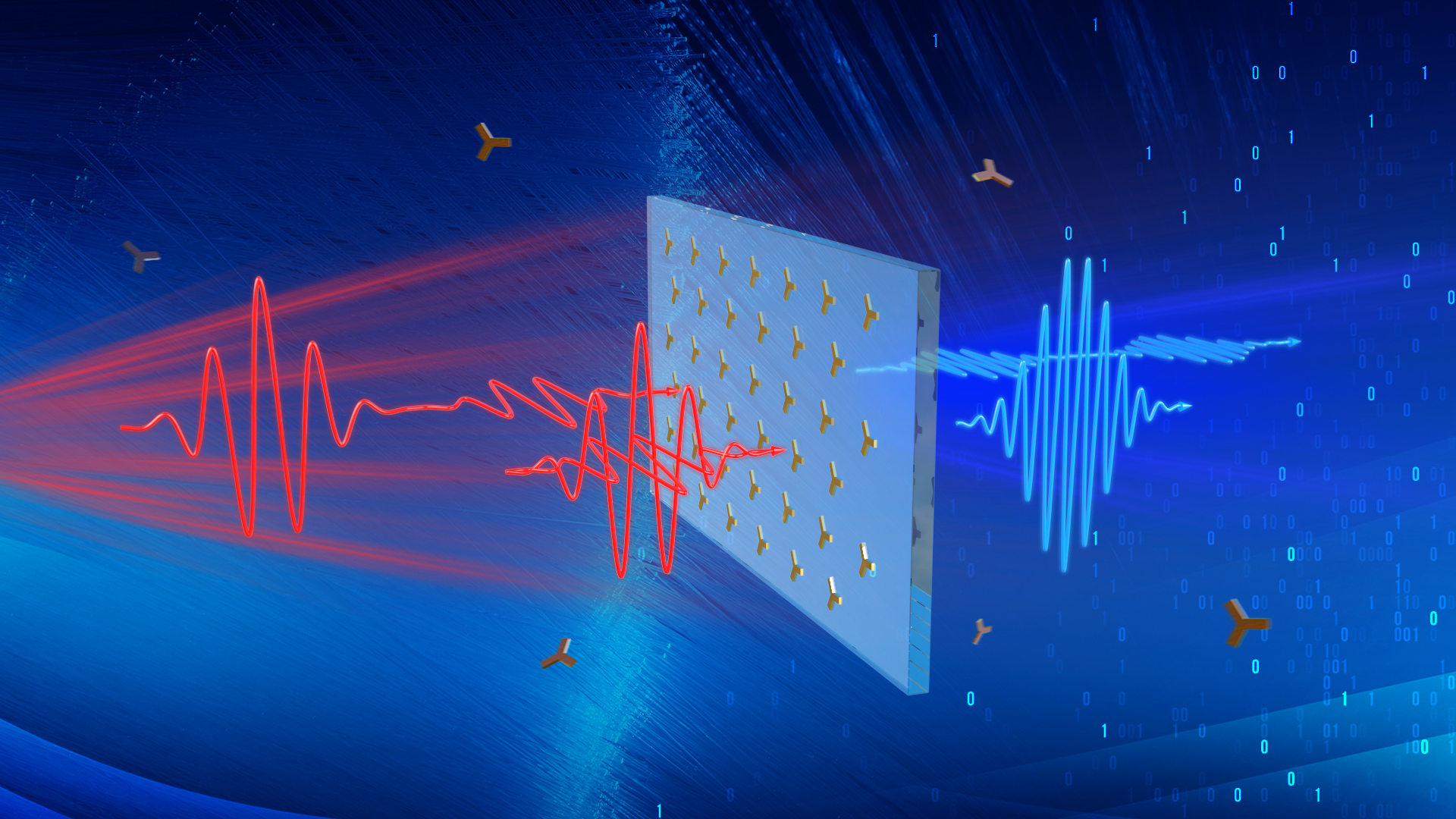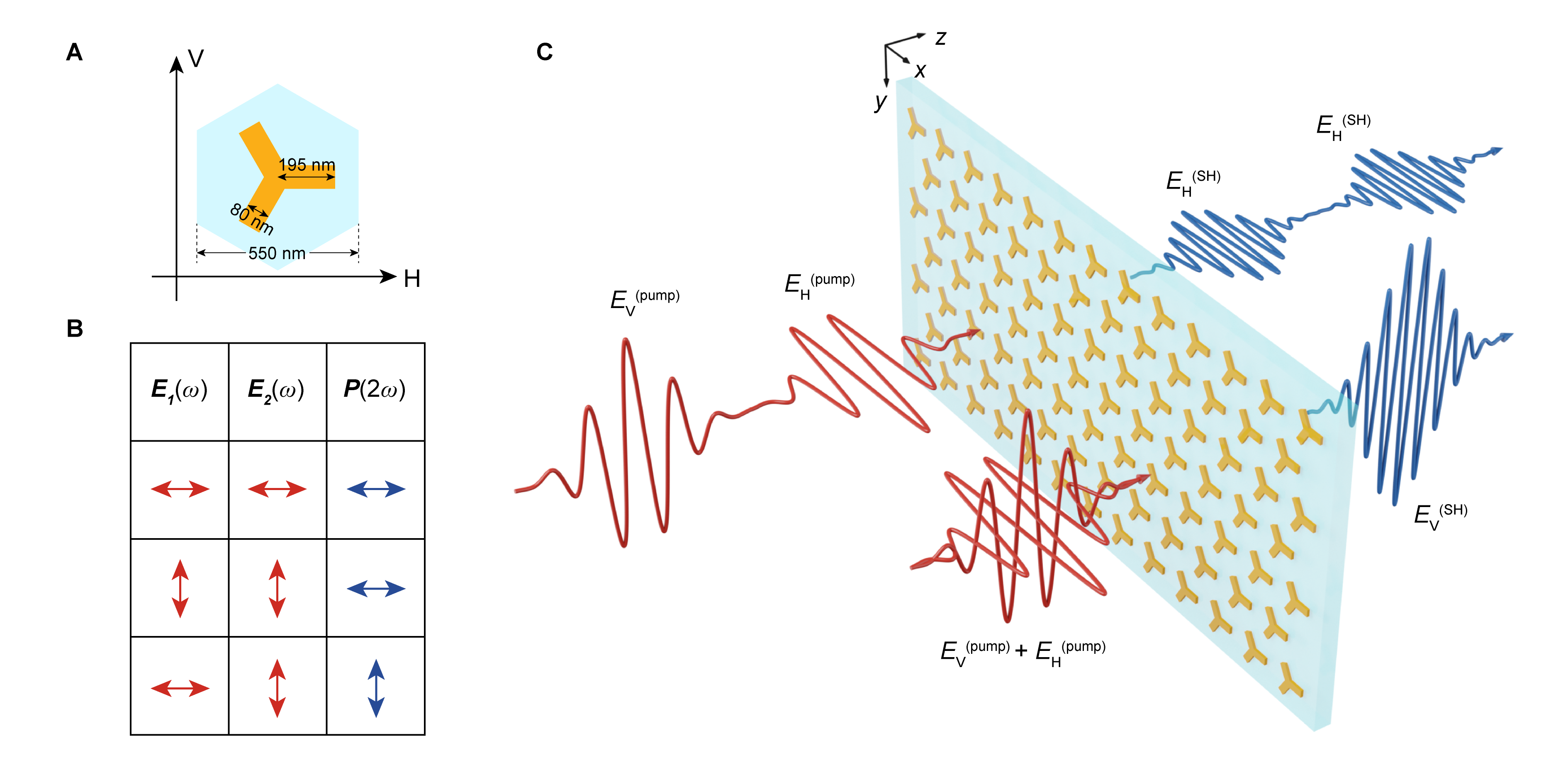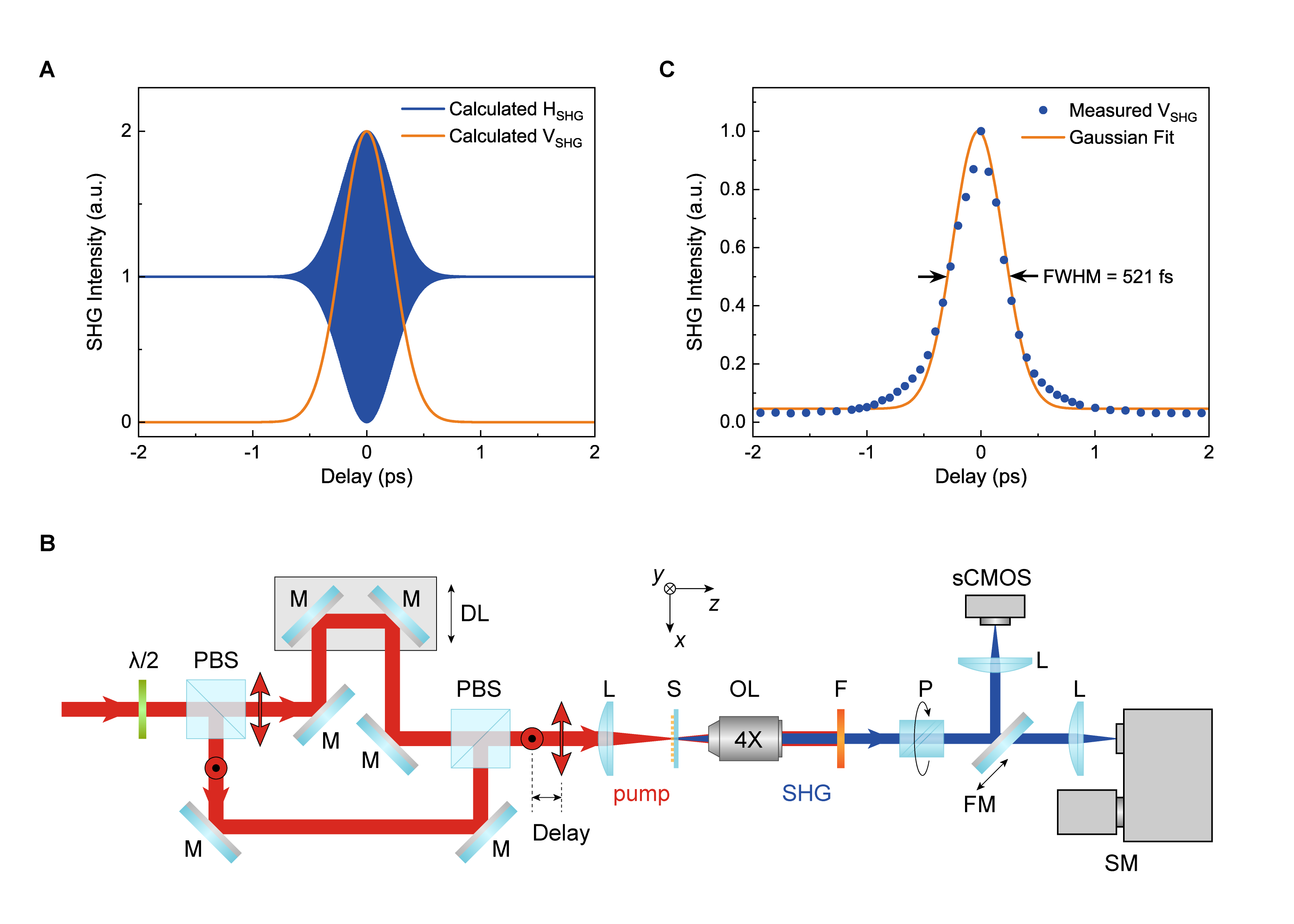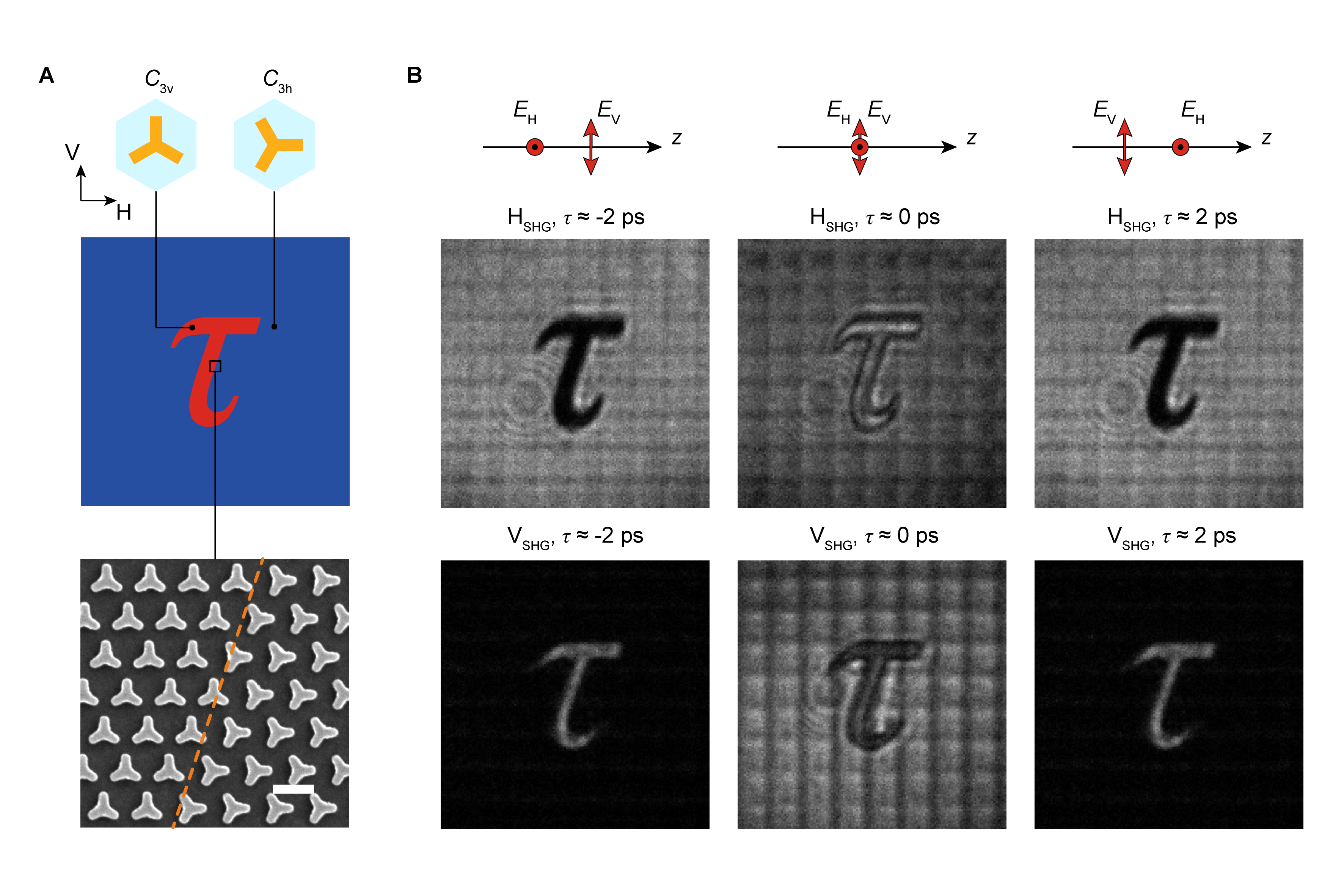Optical switches play key roles in systems that use light as an information carrier, such as optical computing and communications. Switching time and modulation depth are the two key parameters of an optical switch. While the former determines the upper limit of the operating frequency, the latter determines the signal-to-noise ratio. Therefore, developing optical switches with both short switching times and large modulation depths is highly desirable in the optics community.
The physical mechanisms of conventional optical switches include the electro-optical effect, acousto-optical effect, magneto-optical effect, and so on. However, such switches usually suffer from the low switching speed. To circumvent this constraint, all-optical switches based on nonlinear optical processes have been attracting scientists’ attention.

Professor Guixin Li’s research group from the Department of Materials Science and Engineering at the Southern University of Science and Technology (SUSTech) reported an all-optical ultrafast switch by using the second-harmonic generation process on nonlinear plasmonic metasurfaces.
Their paper, entitled “All-optical ultrafast polarization switching with nonlinear plasmonic metasurfaces”, has been published in Science Advances.
In an all-optical switch, the pump beam is usually used to change the properties of the materials, which in turn changes the transmittance or reflectance of the probe beam. The Kerr effect, in which the refractive index of a material depends on the intensity of the pumping light, is one of the most important mechanisms for all-optical switching.
In the past years, a variety of designs of all-optical switches based on the on-chip interferometer, waveguide ring resonator, photonic crystal cavity, plasmonic waveguide, and metasurfaces were developed. In these studies, there are usually trade-offs between switching time and modulation depth of all-optical switches. The large modulation depth of all-optical switches usually requires a long light-matter interaction length, which will inevitably increase the switching time. On the other hand, if the switching time of all-optical switches are short, the modulation depths are usually small.
Second-harmonic generation (SHG) process provides an excellent solution for compromising both the switching time and modulation depth of an all-optical switch. SHG usually occurs in materials with centrosymmetry breaking, such as metals, optical crystals, 2D materials, and metasurfaces. To achieve a SHG-based optical switch, several mechanisms, including hot-electron transfer, Floquet engineering, and photocurrent-induced symmetry breaking, have been proposed. In addition, symmetry selective polarization switching in the SHG, third-harmonic generation, and four-wave mixing processes were successfully demonstrated on the 2D materials platform, which provides an alternative approach for all-optical switching. In such kinds of all-optical switches, the modulation depth is usually very large, and the switching time is only limited by the pulse width of the pumping light. Recent progress in nonlinear plasmonic metasurface offers an alternative approach for developing high-performance optical switches.
The work by Professor Li’s group reports the all-optical ultrafast and large-modulation-depth polarization switching based on the SHG process on a plasmonic metasurface. As shown in Figure 1, the metasurface consists of gold meta-atoms with three-fold rotational symmetry (C3). When the time delay between the two pump pulses is larger than the pulse duration, H- (horizontal) polarized SH waves are generated. In comparison, when two pump pulses coincide in the time domain, V- (vertical) polarized SH waves can be observed. Therefore, this plasmonic metasurface has the potential to be used for all-optical ultrafast polarization switching.

Figure 1. All-optical polarization switching of the SH waves with a plasmonic metasurface. (A) The geometrical parameters of a C3h gold meta-atom. (B) Different combinations of the two pump beams (red arrow) with H- and V-polarization correspond to the generated SH waves (blue arrow) with H- or V-polarization. (C) Schematic diagram of all-optical polarization switching of SH waves with the plasmonic metasurface. When the time delay between two pump pulses is larger than the pulse duration, H-polarized SH waves are generated. When two pump pulses coincide in the time domain, the V-polarized SH waves can be observed.
The working principle of the all-optical switch is as follows. The linearly polarized pump wave with the polarization angle α could be expressed as a superposition of left- and right-circular polarization states with the phase ±α, respectively. According to the principle of nonlinear geometric phase, for left-handed and right-handed circularly polarized pump waves, the corresponding generated right-handed and left-handed circularly polarized SH waves carry the geometric phase of ∓3θ, where θ is the orientation angle of the meta-atom.
However, when pump waves with H- and V- polarization coincide in the time domain, the generated SH wave is switched to V-polarization, which is perpendicular to that of the SH wave in the former case. It, therefore, has the potential to be used for all-optical ultrafast polarization switching. For a Gaussian pulse, the calculated delay-dependent intensities of the SH waves with H- and V-polarization are shown in Figure 2A. The H-polarized SH wave exhibits a Gaussian envelope with an oscillating signal, and the V-polarized one shows a simple Gaussian curve. The width of the V-polarized SHG signal is dependent on the pulse width of the pump wave, indicating the pulse-width limited all-optical switching. Moreover, the SHG signal is close to zero at the delay time, much longer than the pulse width, which means that the optical switching is background-free and the theoretical modulation depth is up to 100%.
The experimental setup used for verifying the all-optical ultrafast polarization switching of the SH waves with the uniform plasmonic metasurface is shown in Figure 2B. A switching time of 521 femtoseconds and a modulation depth of 97% were experimentally achieved (Figure 2C).

Figure 2. All-optical ultrafast polarization switching with the uniform plasmonic metasurface. (A) Calculated delay-dependent intensities of the SH waves with H- and V-polarization, where τ0 = 221.3 fs and the wavelength of 1220 nm of the pump wave are used for calculation. (B) Experimental setup for the ultrafast all-optical polarization switching. (C) Measured delay-dependent V-polarized SHG intensity from the uniform plasmonic metasurface. The delay-dependent SHG intensity is fitted by the Gaussian function (solid line) with a full-width at half-maximum (FWHM) of 521 fs.
To further demonstrate the capability of parallel information processing of the all-optical ultrafast switch, the researchers designed and fabricated the dual-channel plasmonic metasurface, which is composed of pattern-determined meta-atoms with different orientations (Figure 3A). The captured V- and H-polarized SH images at different delay times are shown in Figure 3B. It can be seen that the “τ” region radiates V-polarized SH waves when the delay time is larger than the pulse width. When the two pump waves coincide in the time domain, the “τ” region emits H-polarized SH waves. In comparison, the surrounding area has a complementary SHG intensity distribution with respect to the “τ” region. The ultrafast polarization switching of a binary image demonstrates the capability of parallel information processing with the metasurface optical switch.

Figure 3. All-optical ultrafast polarization switching with the dual-channel plasmonic metasurface. (A) Schematic diagram of the dual-channel plasmonic metasurface with a “τ” pattern. In the region of “τ” (red), the meta-atoms are C3v (one arm vertical), and the surrounding meta-atoms are C3h (one arm horizontal). The scanning electron microscopy (SEM) image of the metasurface is shown below (scale bar: 500 nm), in which the orange dashed line marks the boundary between the two kinds of meta-atoms. (B) Captured SHG images from the metasurface for the two pump waves with H- and V-polarization and different delay times (τ).
The metasurface platform is easy to be scaled up and allows for the design of parallel switching channels. This work may provide a promising route for all-optical ultrafast information processing with nonlinear photonic metasurfaces. The proposed methodology can be used to control the vectorial fields, and the spin and orbital angular momentum of light in the time domain. Many functions, such as all-optical logic gating, optical auto-correlation, and time-varying optical holography, can be developed.
Research Assistant Professor Heng Wang and Ph.D. student Zixian Hu from the Department of Materials Science and Engineering at SUSTech are the co-first authors. Professor Guixin Li is the corresponding author. Senior Research Scientist Kingfai Li, Research Assistant Professor Junhong Deng, and Ph.D. students Xuecai Zhang and Jiafei Chen also made important contributions.
This work was supported by the National Key Technologies R&D Program of China, Zhangjiang Laboratory, National Natural Science Foundation of China (NSFC), Guangdong Provincial Innovation and Entrepreneurship Project, and Natural Science Foundation of Shenzhen Innovation Commission.
Paper link: https://www.science.org/doi/epdf/10.1126/sciadv.adk3882
To read all stories about SUSTech science, subscribe to the monthly SUSTech Newsletter.
Proofread ByAdrian Cremin, Yingying XIA
Photo ByDepartment of Materials Science and Engineering